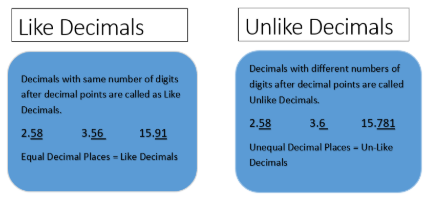Like, Unlike Decimals and Ordering of Decimals for Class 4
This is a comprehensive lesson plan for teaching like, unlike decimals and ordering of decimals to grade 4 students. The lesson is designed to make the concepts easy and engage students with activities like quizzes, practice questions and worksheets.
Teachers can use this guide as a reference for delivering the concepts to students and engaging them in the classroom with the various questions and examples given in this page.
For parents, there are 12 downloadable practice worksheets that they can use for their kids.
In this article, you will learn
- Like and unlike decimals, as well as the method for converting unlike decimals into like decimals
- Ordering of decimals
Introduction to Like & Unlike Decimals
Decimals are numbers that have a whole number part and a fractional part, separated by a decimal point. For example, in the number 3.45, "3" is the whole number part, and ".45" is the fractional part.

1. Like Decimals
Like decimals are those that have the same number of decimal places. This makes them easier to compare and perform operations with.
Like decimals example:
- 1.25, 2.34, 5.67 (all have two decimal places)
- 3.456, 7.123, 9.789 (all have three decimal places)
They are called "like" decimals, because they line up neatly when aligned, making comparison and calculation easy.
2. Unlike Decimals
Unlike decimals, are those that do not have the same number of decimal places. These decimals might need to be adjusted, such as adding zeros to make them easier to compare or add.
Examples of Unlike Decimals:
- 2.4, 1.56, 7.123
- 0.5, 3.78, 10.03
To work with unlike decimals, you can add zeros to the end of the shorter decimals so they have the same number of decimal places. For example, you can change 2.4 to 2.400 to compare it with 1.560 and 7.123.
Practice Questions:
- Convert the following to like decimals: 5.3, 2.45, 7.8, and 0.67.
- Compare the following decimals: 2.45 or 2.5
- Change the following unlike decimals into like decimals: 3.1, 15.789, 2.4, and 0.56.
- Identify and separate the following as like and unlike decimals: 6.2, 3.78, 4.05, 12.345, and 0.9
Ordering Decimals
Ordering decimals means placing them in order from smallest to largest (in ascending order) or from largest to smallest (in descending order).
How to do it?
Make Sure All Decimals Have the Same Number of Decimal Places: If the decimals are unlike, adjust them by adding zeros so they match in decimal places.
Example: Order 3.4, 2.35, and 3.456 by rewriting them as: 3.400, 2.350, 3.456.
Compare the whole number parts. The smallest whole number is the smallest decimal.
Example: In 2.350, 3.400, and 3.456, the smallest whole number is 2.
When the whole numbers are equal, compare the decimals by comparing digits after the decimal point from left to right, if two or more decimals have equal whole number parts.
Example: To order 3.45, 3.456, and 3.4
- Rewrite as 3.450, 3.456, and 3.400
- Compare the numbers digit by digit:
- 3.400 < 3.450 < 3.456
Practice Examples:
- Order these decimals from smallest to largest: 4.2, 4.156, 4.18
- Order these decimals from largest to smallest: 1.25, 1.3, 1.205
FAQs
1. What are like and unlike decimals?
Like decimals are decimals that have the same number of decimal places. For example, 2.30 and 3.45 are like decimals because both have two decimal places. Unlike decimals have a different number of decimal places. For instance, 2.3 and 2.345 are unlike decimals because one has one decimal place and the other has three.
2. Give examples of like decimals.
Yes, here are some examples of like decimals: 1.25, 2.75, and 3.10. All these decimals have two places after the decimal point, thus making them like decimals.
3. How do you convert unlike decimals to like decimals?
Unlike decimals are converted to like decimals by adding zeroes to the end of the decimals so that they have the same number of decimal places. For instance, you can write 2.3 and 2.345 as 2.300 and 2.345, respectively.
4. How do you compare decimals from least to greatest?
Comparing decimals from least to greatest first converts to like decimals if necessary, then compares numbers digit by digit from left to right. For instance, to compare 2.3, 2.35, and 2.305, convert them to 2.300, 2.350, and 2.305, then order them as 2.300, 2.305, 2.350.
5. Are 2.30 and 2.03 like decimals?
Yes, 2.30 and 2.03 are like decimals because they both have two decimal places but even though they appear like decimals, they can represent different values.
6. Give some examples of comparing decimals.
Comparing decimals is about looking at the digits from left to right. For example, to compare 1.45 and 1.456 you look at the whole number part (1 and 1 are equal), then the tenths place (4 and 4 are equal) and finally, the hundredths place (5 vs. 5). The extra digit in the thousandths place in 1.456 makes it bigger.
Orchid's learning material
Click the button to download the e-book
Things you have learned!
- Like and unlike decimals
- How to convert unlike decimals into like decimals
- How to compare and order decimals easily











